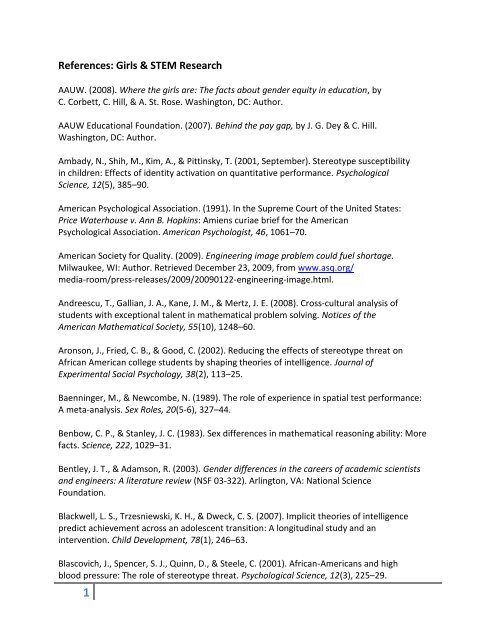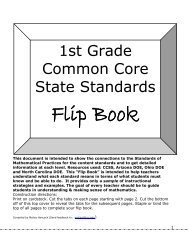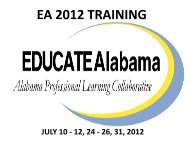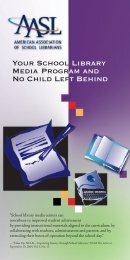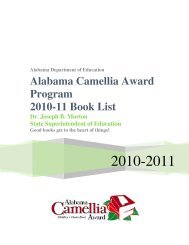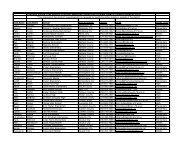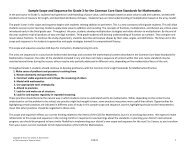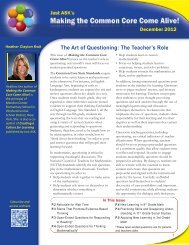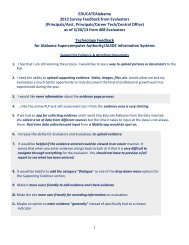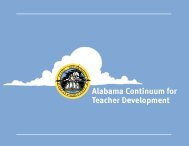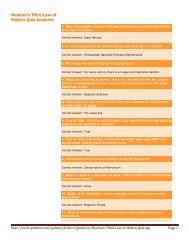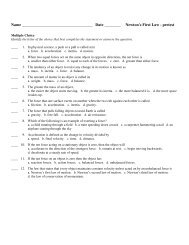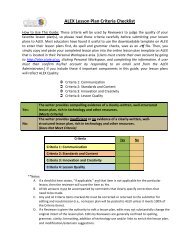Research Biography on Girls and STEM - Alex
Research Biography on Girls and STEM - Alex
Research Biography on Girls and STEM - Alex
Create successful ePaper yourself
Turn your PDF publications into a flip-book with our unique Google optimized e-Paper software.
References: <strong>Girls</strong> & <strong>STEM</strong> <str<strong>on</strong>g>Research</str<strong>on</strong>g><br />
AAUW. (2008). Where the girls are: The facts about gender equity in educati<strong>on</strong>, by<br />
C. Corbett, C. Hill, & A. St. Rose. Washingt<strong>on</strong>, DC: Author.<br />
AAUW Educati<strong>on</strong>al Foundati<strong>on</strong>. (2007). Behind the pay gap, by J. G. Dey & C. Hill.<br />
Washingt<strong>on</strong>, DC: Author.<br />
Ambady, N., Shih, M., Kim, A., & Pittinsky, T. (2001, September). Stereotype susceptibility<br />
in children: Effects of identity activati<strong>on</strong> <strong>on</strong> quantitative performance. Psychological<br />
Science, 12(5), 385–90.<br />
American Psychological Associati<strong>on</strong>. (1991). In the Supreme Court of the United States:<br />
Price Waterhouse v. Ann B. Hopkins: Amiens curiae brief for the American<br />
Psychological Associati<strong>on</strong>. American Psychologist, 46, 1061–70.<br />
American Society for Quality. (2009). Engineering image problem could fuel shortage.<br />
Milwaukee, WI: Author. Retrieved December 23, 2009, from www.asq.org/<br />
media-room/press-releases/2009/20090122-engineering-image.html.<br />
Andreescu, T., Gallian, J. A., Kane, J. M., & Mertz, J. E. (2008). Cross-cultural analysis of<br />
students with excepti<strong>on</strong>al talent in mathematical problem solving. Notices of the<br />
American Mathematical Society, 55(10), 1248–60.<br />
Ar<strong>on</strong>s<strong>on</strong>, J., Fried, C. B., & Good, C. (2002). Reducing the effects of stereotype threat <strong>on</strong><br />
African American college students by shaping theories of intelligence. Journal of<br />
Experimental Social Psychology, 38(2), 113–25.<br />
Baenninger, M., & Newcombe, N. (1989). The role of experience in spatial test performance:<br />
A meta-analysis. Sex Roles, 20(5-6), 327–44.<br />
Benbow, C. P., & Stanley, J. C. (1983). Sex differences in mathematical reas<strong>on</strong>ing ability: More<br />
facts. Science, 222, 1029–31.<br />
Bentley, J. T., & Adams<strong>on</strong>, R. (2003). Gender differences in the careers of academic scientists<br />
<strong>and</strong> engineers: A literature review (NSF 03-322). Arlingt<strong>on</strong>, VA: Nati<strong>on</strong>al Science<br />
Foundati<strong>on</strong>.<br />
Blackwell, L. S., Trzesniewski, K. H., & Dweck, C. S. (2007). Implicit theories of intelligence<br />
predict achievement across an adolescent transiti<strong>on</strong>: A l<strong>on</strong>gitudinal study <strong>and</strong> an<br />
interventi<strong>on</strong>. Child Development, 78(1), 246–63.<br />
Blascovich, J., Spencer, S. J., Quinn, D., & Steele, C. (2001). African-Americans <strong>and</strong> high<br />
blood pressure: The role of stereotype threat. Psychological Science, 12(3), 225–29.<br />
1
Brainard, S. G., & Carlin, L. (1998). A six-year l<strong>on</strong>gitudinal study of undergraduate women in<br />
engineering <strong>and</strong> science. Journal of Engineering Educati<strong>on</strong>, 87(4), 369–75.<br />
Brody, L. E., & Mills, C. J. (2005). Talent search research: What have we learned? High<br />
Ability Studies, 16(1), 97–111.<br />
98 AAUW<br />
Buck, G. A., Plano Clark, V. L., Leslie-Pelecky, D., Lu, Y., & Cerda-Lizarraga, P. (2008).<br />
Examining the cognitive processes used by adolescent girls <strong>and</strong> women scientists in<br />
identifying science role models: A feminist approach. Science Educati<strong>on</strong>, 92(4),<br />
688–707.<br />
Ceci, S. J., Williams, W. M., & Barnett, S. M. (2009). Women’s underrepresentati<strong>on</strong> in science:<br />
Sociocultural <strong>and</strong> biological c<strong>on</strong>siderati<strong>on</strong>s. Psychological Bulletin, 135(2), 218–61.<br />
Coho<strong>on</strong>, J. M., & Aspray, W. (2006). A critical review of the research <strong>on</strong> women’s participati<strong>on</strong><br />
in postsec<strong>on</strong>dary computing educati<strong>on</strong>. In J. M. Coho<strong>on</strong> & W. Aspray (Eds.),<br />
Women <strong>and</strong> informati<strong>on</strong> technology: <str<strong>on</strong>g>Research</str<strong>on</strong>g> <strong>on</strong> under-representati<strong>on</strong> (pp. 137–79).<br />
Cambridge, MA: MIT Press.<br />
Cooper, S. E., & Robins<strong>on</strong>, D. A. G. (1991). The relati<strong>on</strong>ship of mathematics self-efficacy<br />
beliefs to mathematics anxiety <strong>and</strong> performance. Measurement <strong>and</strong> Evaluati<strong>on</strong> in<br />
Counseling <strong>and</strong> Development, 24(1), 4–11.<br />
Correll, S. J. (2001). Gender <strong>and</strong> the career choice process: The role of biased self-assessments.<br />
American Journal of Sociology, 106(6), 1691–1730.<br />
———. (2004). C<strong>on</strong>straints into preferences: Gender, status, <strong>and</strong> emerging career aspirati<strong>on</strong>s.<br />
American Sociological Review, 69(1), 93–113.<br />
Diekman, A. B., Brown, E. R., Johnst<strong>on</strong>, A. M., & Clark, E. K. (2009, June). Communal goals<br />
as inhibitors of <strong>STEM</strong> careers. Poster presented at the Nati<strong>on</strong>al Science Foundati<strong>on</strong><br />
Joint Annual Meeting, Washingt<strong>on</strong>, DC.<br />
Di Fabio, N. M., Br<strong>and</strong>i, C., & Frehill, L. M. (2008). Professi<strong>on</strong>al women <strong>and</strong> minorities: A<br />
total human resources data compendium. Washingt<strong>on</strong>, DC: Commissi<strong>on</strong> <strong>on</strong><br />
Professi<strong>on</strong>als in Science <strong>and</strong> Technology.<br />
Dweck, C. (2006). Is math a gift? Beliefs that put females at risk. In S. J. Ceci & W. M.<br />
Williams (Eds.), Why aren’t more women in science? Top researchers debate the<br />
evidence (pp. 47–55). Washingt<strong>on</strong>, DC: American Psychological Associati<strong>on</strong>.<br />
———. (2008). Mindsets <strong>and</strong> math/science achievement. New York: Carnegie Corporati<strong>on</strong> of<br />
New York, Institute for Advanced Study, Commissi<strong>on</strong> <strong>on</strong> Mathematics <strong>and</strong> Science<br />
2
Educati<strong>on</strong>.<br />
Dweck, C., & Leggett, E. L. (1988). A social-cognitive approach to motivati<strong>on</strong> <strong>and</strong><br />
pers<strong>on</strong>ality. Psychological Review, 95(2), 256–73.<br />
Eccles, J. S. (1994). Underst<strong>and</strong>ing women’s educati<strong>on</strong>al <strong>and</strong> occupati<strong>on</strong>al choices:<br />
Applying the Eccles et al. model of achievement-related choices. Psychology of<br />
Women Quarterly, 18(4), 585–609.<br />
———. ( 2006). Where are all the women? Gender differences in participati<strong>on</strong> in physical<br />
science <strong>and</strong> engineering. In S. J. Ceci & W. M. Williams (Eds.), Why aren’t more<br />
women in science? Top researchers debate the evidence (pp. 199–210). Washingt<strong>on</strong>, DC:<br />
American Psychological Associati<strong>on</strong>.<br />
Why So Few? 99<br />
Eccles (Pars<strong>on</strong>s), J. S., Adler, T. F., Futterman, R., Goff, S. B., Kaczala, C. M., Meece, J. L.,<br />
& Midgley, C. (1983). Expectancies, values, <strong>and</strong> academic behaviors. In J. T. Spence<br />
(Ed.), Perspective <strong>on</strong> achievement <strong>and</strong> achievement motivati<strong>on</strong> (pp. 75–146). San<br />
Francisco: W. H. Freeman.<br />
Eisenhart, M. (2008, October). We can’t get there from here: High school girls c<strong>on</strong>sider<br />
engineering.<br />
Presentati<strong>on</strong> for a Women in Engineering ProActive Network (WEPAN) nati<strong>on</strong>al<br />
webcast.<br />
Farenga, S. J., & Joyce, B. A. (1999). Intenti<strong>on</strong>s of young students to enroll in science courses<br />
in the future: An examinati<strong>on</strong> of gender differences. Science Educati<strong>on</strong>, 83(1), 55–76.<br />
Foschi, M. (1996). Double st<strong>and</strong>ards in the evaluati<strong>on</strong> of men <strong>and</strong> women. Social Psychology<br />
Quarterly, 59(3), 237–54.<br />
Fouad, N. A., & Walker, C. M. (2005). Cultural influences <strong>on</strong> resp<strong>on</strong>ses to items <strong>on</strong> the<br />
Str<strong>on</strong>g Interest Inventory. Journal of Vocati<strong>on</strong>al Behavior, 66(1), 104–23.<br />
Frehill, L. M., Br<strong>and</strong>i, C., Di Fabio, N., Keegan, K., & Hill, S. T. (2009, Summer). Women in<br />
engineering: A review of the 2008 literature. SWE Magazine, 55, 28–56.<br />
Frehill, L. M., Di Fabio, N., Hill, S., Trager, K., & Bu<strong>on</strong>o, J. (2008, Summer). Women in<br />
engineering: A review of the 2007 literature. SWE Magazine, 54(3), 6–30.<br />
Frizell, S., & Nave, F. (2008). A preliminary analysis of factors affecting the persistence of<br />
African-American females in engineering degree programs. Paper presented at the<br />
American Society for Engineering Educati<strong>on</strong> Annual C<strong>on</strong>ference, Pittsburgh, PA.<br />
3
Gibb<strong>on</strong>s, M. T. (2009, June). Engineering by the numbers. In Profiles of engineering <strong>and</strong><br />
engineering technology colleges. Washingt<strong>on</strong>, DC: American Society for<br />
Engineering Educati<strong>on</strong>.<br />
Ginther, D. K., & Kahn, S. (2006). Does science promote women? Evidence from academia<br />
1973–2001 (NBER Working Paper W12691). Cambridge, MA: Nati<strong>on</strong>al Bureau of<br />
Ec<strong>on</strong>omic <str<strong>on</strong>g>Research</str<strong>on</strong>g>.<br />
Good, C., Ar<strong>on</strong>s<strong>on</strong>, J., & Harder, J. A. (2008). Problems in the pipeline: Stereotype threat <strong>and</strong><br />
women’s achievement in high-level math courses. Journal of Applied Developmental<br />
Psychology, 29(1), 17–28.<br />
Good, C., Ar<strong>on</strong>s<strong>on</strong>, J., & Inzlicht, M. (2003). Improving adolescents’ st<strong>and</strong>ardized test<br />
performance: An interventi<strong>on</strong> to reduce the effects of stereotype threat. Applied<br />
Developmental Psychology, 24, 645–62.<br />
Good, C., Rattan, A., & Dweck, C. S. (2009). Why do women opt out? Sense of bel<strong>on</strong>ging<br />
<strong>and</strong> women’s representati<strong>on</strong> in mathematics. Unpublished paper, Baruch College,<br />
Stanford University.<br />
Goulden, M., Frasch, K., & Mas<strong>on</strong>, M. A. (2009). Staying competitive: Patching America’s<br />
leaky pipeline in the sciences. Berkeley: University of California, Berkeley Center <strong>on</strong><br />
Health, Ec<strong>on</strong>omic, & Family Security, & The Center for American Progress.<br />
100 AAUW<br />
Grant, H., & Dweck, C. S. (2003). Clarifying achievement goals <strong>and</strong> their impact. Journal of<br />
Pers<strong>on</strong>ality <strong>and</strong> Social Psychology, 85(3), 541–53.<br />
Guay, R. (1977). Purdue Spatial Visualizati<strong>on</strong> Test: Rotati<strong>on</strong>s. West Lafayette, IN: Purdue<br />
<str<strong>on</strong>g>Research</str<strong>on</strong>g> Foundati<strong>on</strong>.<br />
Guiso, L., M<strong>on</strong>te, F., Sapienza, P., & Zingales, L. (2008, May 30). Culture, gender, <strong>and</strong> math.<br />
Science, 320, 1164–65.<br />
Haier, R. J., Jung, R. E., Yeo, R. A., Head, K., & Alkire, M. T. (2005). The neuroanatomy of<br />
general intelligence: Sex matters. NeuroImage, 25, 320–27.<br />
Halpern, D. F., Ar<strong>on</strong>s<strong>on</strong>, J., Reimer, N., Simpkins, S., Star, J. R., & Wentzel, K. (2007).<br />
Encouraging girls in math <strong>and</strong> science (NCER 2007-2003). Washingt<strong>on</strong>, DC: U.S.<br />
Department of Educati<strong>on</strong>, Nati<strong>on</strong>al Center for Educati<strong>on</strong> <str<strong>on</strong>g>Research</str<strong>on</strong>g>.<br />
Halpern, D. F., Benbow, C. P., Geary, D. C., Gur, R. C., Hyde, J. S., & Gernsbacher, M. A.<br />
(2007). The science of sex differences in science <strong>and</strong> mathematics. Psychological<br />
Science in the Public Interest, 8(1), 1–51.<br />
4
Hans<strong>on</strong>, S. L. (2004). African American women in science: Experiences from high school<br />
through the post-sec<strong>on</strong>dary years <strong>and</strong> bey<strong>on</strong>d. NWSA Journal, 16(1), 96–115.<br />
Hartung, P. J., Porfeli, E. J., & V<strong>on</strong>dracek, F. W. (2005).<br />
Child vocati<strong>on</strong>al development: A review <strong>and</strong> rec<strong>on</strong>siderati<strong>on</strong>. Journal of Vocati<strong>on</strong>al Behavior,<br />
66(3), 385–419.<br />
Hedges, L. V., & Nowell, A. (1995, July 7). Sex differences in mental test scores, variability,<br />
<strong>and</strong> numbers of high-scoring individuals. Science, 269, 41–45.<br />
Heilman, M. E., & Okimoto, T. G. (2007). Why are women penalized for success at male<br />
tasks? The implied communality deficit. Journal of Applied Psychology, 92(1), 81–92.<br />
Heilman, M. E., Wallen, A. S., Fuchs, D., & Tamkins, M. M. (2004). Penalties for success:<br />
Reacti<strong>on</strong> to women who succeed in male gender-typed tasks. Journal of Applied<br />
Psychology, 89(3), 416–27.<br />
Hewlett, S. A., Buck Luce, C., Serv<strong>on</strong>, L. J., Sherbin, L., Shiller, P., Sosnovich, E., & Sumberg,<br />
K. (2008). The Athena Factor: Reversing the brain drain in science, engineering <strong>and</strong><br />
technology (Harvard Business Review <str<strong>on</strong>g>Research</str<strong>on</strong>g> Report). Bost<strong>on</strong>: Harvard Business<br />
Publishing.<br />
Higher Educati<strong>on</strong> <str<strong>on</strong>g>Research</str<strong>on</strong>g> Institute. (2007, January). Survey of the American freshman:<br />
Special tabulati<strong>on</strong>s. Los Angeles, CA: Author.<br />
Holmes, M. A., & O’C<strong>on</strong>nell, S. (2003). Where are the women geoscience professors? Paper<br />
presented at the Nati<strong>on</strong>al Science Foundati<strong>on</strong>, Associati<strong>on</strong> for Women Geoscientists,<br />
<strong>and</strong> Associati<strong>on</strong> for Women Geoscientists Foundati<strong>on</strong>-sp<strong>on</strong>sored workshop,<br />
Washingt<strong>on</strong>, DC.<br />
Hyde, J. S., Lindberg, S. M., Linn, M. C., Ellis, A. B., & Williams, C. C. (2008, July 25).<br />
Gender similarities characterize math performance. Science, 321, 494–95.<br />
Why So Few? 101<br />
Inzlicht, M., & Ben-Zeev, T. (2000). A threatening intellectual envir<strong>on</strong>ment: Why females are<br />
susceptible to experiencing problem-solving deficits in the presence of males.<br />
Psychological Science, 11(5), 365–71.<br />
Ivie, R., & Ray, K. N. (2005). Women in physics <strong>and</strong> astr<strong>on</strong>omy, 2005 (AIP Publicati<strong>on</strong> Number<br />
R-430.02). College Park, MD: American Institute of Physics.<br />
Jacoby, L. L., Kelley, C., Brown, J., & Jasechko, J. (1989). Becoming famous overnight: Limits<br />
<strong>on</strong> the ability to avoid unc<strong>on</strong>scious influences of the past. Journal of Pers<strong>on</strong>ality <strong>and</strong><br />
Social Psychology, 56, 326–38.<br />
5
Johns, M., Schmader, T., & Martens, A. (2005). Knowing is half the battle: Teaching<br />
stereotype threat as a means of improving women’s math performance. Psychological<br />
Science, 16(3), 175–79.<br />
Jozefowicz, D. M., Barber, B. L., & Eccles, J. S. (1993, March 28). Adolescent work-related<br />
values <strong>and</strong> beliefs: Gender differences <strong>and</strong> relati<strong>on</strong> to occupati<strong>on</strong>al aspirati<strong>on</strong>s. Paper<br />
presented at the Biennial Meeting of the Society for <str<strong>on</strong>g>Research</str<strong>on</strong>g> <strong>on</strong> Child<br />
Development, New Orleans, LA.<br />
Kimura, D. (2002). Sex horm<strong>on</strong>es influence human cognitive pattern. Neuroendocrinology<br />
Letters, 23(Suppl. 4), 67–77.<br />
K<strong>on</strong>rad, A. M., Ritchie, J. E., Jr., Lieb, P., & Corrigall, E. (2000). Sex differences <strong>and</strong><br />
similarities in job attribute preferences: A meta-analysis. Psychological Bulletin,<br />
126(4), 593–641.<br />
Kulis, S., Sicotte, D., & Collins, S. (2002). More than a pipeline problem: Labor supply<br />
c<strong>on</strong>straints <strong>and</strong> gender stratificati<strong>on</strong> across academic science disciplines. <str<strong>on</strong>g>Research</str<strong>on</strong>g> in<br />
Higher Educati<strong>on</strong>, 43(6), 657–91.<br />
Lacey, T. A., & Wright, B. (2009, November). Occupati<strong>on</strong>al employment projecti<strong>on</strong>s to 2018.<br />
M<strong>on</strong>thly Labor Review, 132(11), 82–123.<br />
Lapan, R. T., Adams, A., Turner, S., & Hinkelman, J. M. (2000). Seventh graders’ vocati<strong>on</strong>al<br />
interest <strong>and</strong> efficacy expectati<strong>on</strong> patterns. Journal of Career Development, 26(3),<br />
215–29.<br />
Lent, R. W., Brown, S. D., & Larkin, K. C. (1986). Self-efficacy in the predicti<strong>on</strong> of academic<br />
performance <strong>and</strong> perceived career opti<strong>on</strong>s. Journal of Counseling Psychology, 33(3),<br />
265–69.<br />
Linn, M. C., & Petersen, A. C. (1985). Emergence <strong>and</strong> characterizati<strong>on</strong> of sex differences in<br />
spatial ability: A meta-analysis. Child Development, 56(6), 1479–98.<br />
Lovaglia, M. J., Lucas, J. W., Houser, J. A., Thye, S. R., & Markovsky, B. (1998). Status<br />
processes <strong>and</strong> mental ability test scores. American Journal of Sociology, 104(1),<br />
195–228.<br />
Low, K. S. D., Yo<strong>on</strong>, M., Roberts, B. W., & Rounds, J. (2005). The stability of vocati<strong>on</strong>al<br />
interests from early adolescence to middle adulthood: A quantitative review of<br />
l<strong>on</strong>gitudinal studies. Psychological Bulletin, 131(5), 713–37.<br />
102 AAUW<br />
6
Lubinski, D., & Benbow, C. P. (1992). Gender differences in abilities <strong>and</strong> preferences am<strong>on</strong>g<br />
the gifted: Implicati<strong>on</strong>s for the math-science pipeline. Current Directi<strong>on</strong>s in<br />
Psychological Science, 1(2), 61–66.<br />
———. (2006). Study of mathematically precocious youth after 35 years: Uncovering<br />
antecedents for the development of math-science expertise. Perspectives <strong>on</strong><br />
Psychological Science, 1(4), 316–45.<br />
Lynn, R., & Irwing, P. (2004). Sex differences <strong>on</strong> the Progressive Matrices: A meta-analysis.<br />
Intelligence, 32(5), 481–98.<br />
Macfarlane, A., & Luzzadder-Beach, S. (1998). Achieving equity between women <strong>and</strong> men in<br />
the geosciences. Geological Society of America Bulletin, 110(12), 1590–1614.<br />
Margolis, J., & Fisher, A. (2002). Unlocking the clubhouse: Women in computing. Cambridge:<br />
Massachusetts Institute of Technology.<br />
Margolis, J., Fisher, A., & Miller, F. (2002). Caring about c<strong>on</strong>necti<strong>on</strong>s: Gender <strong>and</strong> computing.<br />
Pittsburgh, PA: Carnegie Mell<strong>on</strong> University, School of Computer Science.<br />
7
Mas<strong>on</strong>, M. A., & Goulden, M. (2002, November-December). Do babies matter? The effect of<br />
family formati<strong>on</strong> <strong>on</strong> the lifel<strong>on</strong>g careers of academic men <strong>and</strong> women. Academe,<br />
88(6), 21–27.<br />
———. (2004). Marriage <strong>and</strong> baby blues: Redefining gender equity in the academy. Annals of<br />
the American Academy of Political <strong>and</strong> Social Science, 596(1), 86–103.<br />
Mas<strong>on</strong>, M. A., Goulden, M., & Frasch, K. (2009, January-February). Why graduate students<br />
reject the fast track. Academe Online, 95(1).<br />
Massachusetts Institute of Technology. School of Science. Committee <strong>on</strong> Women Faculty.<br />
(1999). A study of the status of women faculty in science at MIT. Cambridge, MA.<br />
May, G. S., & Chubin, D. E. (2003). A retrospective <strong>on</strong> undergraduate engineering success for<br />
underrepresented minority students. Journal of Engineering Educati<strong>on</strong>, 92(1), 27–40.<br />
McIntyre, R. B., Lord, C. G., Gresky, D. M., Ten Eyck, L. L., Frye, G. D. J., & B<strong>on</strong>d, C. F., Jr. (2005).<br />
A social impact trend in the effects of role models <strong>on</strong> alleviating women’s<br />
mathematics stereotype threat. Current <str<strong>on</strong>g>Research</str<strong>on</strong>g> in Social Psychology, 10(9), 116–36.<br />
McIntyre, R. B., Pauls<strong>on</strong>, R. M., & Lord, C. G. (2003). Alleviating women’s mathematics<br />
stereotype threat through salience of group achievements. Journal of Experimental<br />
Social Psychology, 39(1), 83–90.<br />
Munro, N. (2009, July 4). Science faces Title IX test. Nati<strong>on</strong>al Journal Magazine.<br />
Nati<strong>on</strong>al Academy of Engineering. Committee <strong>on</strong> Public Underst<strong>and</strong>ing of Engineering<br />
Messages. (2008). Changing the c<strong>on</strong>versati<strong>on</strong>: Messages for improving public<br />
underst<strong>and</strong>ing of engineering. Washingt<strong>on</strong>, DC: Nati<strong>on</strong>al Academies Press.<br />
Nati<strong>on</strong>al Academy of Sciences. (2007). Bey<strong>on</strong>d bias <strong>and</strong> barriers: Fulfilling the potential of<br />
women in academic science <strong>and</strong> engineering. Washingt<strong>on</strong>, DC: Nati<strong>on</strong>al Academies<br />
Press.<br />
Why So Few? 103<br />
Nati<strong>on</strong>al Academy of Sciences. Committee <strong>on</strong> Science, Engineering & Public Policy. (2007).<br />
Rising above the gathering storm: Energizing <strong>and</strong> employing America for a brighter<br />
ec<strong>on</strong>omic future. Washingt<strong>on</strong>, DC: Nati<strong>on</strong>al Academies Press.<br />
Nati<strong>on</strong>al Associati<strong>on</strong> of Colleges <strong>and</strong> Employers. (2009, Fall). Salary survey.<br />
Nati<strong>on</strong>al <str<strong>on</strong>g>Research</str<strong>on</strong>g> Council. (2009). Gender differences at critical transiti<strong>on</strong>s in the careers of<br />
science, engineering <strong>and</strong> mathematics faculty. Washingt<strong>on</strong>, DC: Nati<strong>on</strong>al Academies<br />
Press.<br />
8
Nati<strong>on</strong>al <str<strong>on</strong>g>Research</str<strong>on</strong>g> Council. Committee <strong>on</strong> Support for Thinking Spatially. (2006). Learning to<br />
think spatially: GIS as a support system in the K-12 curriculum. Washingt<strong>on</strong>, DC:<br />
Nati<strong>on</strong>al Academies Press.<br />
Nati<strong>on</strong>al Science Board. (2008). Science <strong>and</strong> engineering indicators 2008 (Volume 1, NSB<br />
08-01; Volume 2, NSB 08-01A). Arlingt<strong>on</strong>, VA: Nati<strong>on</strong>al Science Foundati<strong>on</strong>.<br />
———. (2010). Science <strong>and</strong> engineering indicators 2010 (NSB 10-01). Arlingt<strong>on</strong>, VA:<br />
Nati<strong>on</strong>al Science Foundati<strong>on</strong>.<br />
Nati<strong>on</strong>al Science Foundati<strong>on</strong>. Divisi<strong>on</strong> of Science Resources Statistics. (2008). Science <strong>and</strong><br />
engineering degrees: 1966–2006 (Detailed Statistical Tables) (NSF 08-321).<br />
Arlingt<strong>on</strong>, VA: Author. Retrieved December 22, 2009, from www.nsf.gov/<br />
statistics/nsf08321/pdf/nsf08321.pdf.<br />
———. (2009a). Characteristics of doctoral scientists <strong>and</strong> engineers in the United States: 2006<br />
(Detailed Statistical Tables) (NSF 09-317). Arlingt<strong>on</strong>, VA: Author.<br />
———. (2009b). Women, minorities, <strong>and</strong> pers<strong>on</strong>s with disabilities in science <strong>and</strong> engineering:<br />
2009<br />
(NSF 09-305). Arlingt<strong>on</strong>, VA: Author. Retrieved December 22, 2009, from<br />
www.nsf.gov/statistics/wmpd.<br />
Nels<strong>on</strong>, D. J., & Rogers, C. (n.d.). A nati<strong>on</strong>al analysis of diversity in science <strong>and</strong> engineering<br />
faculties at research universities. Retrieved October 24, 2009, from www.now.org/<br />
issues/diverse/diversity_report.pdf.<br />
Nguyen, H.-H. H., & Ryan, A. M. M. (2008). Does stereotype threat affect test performance<br />
of minorities <strong>and</strong> women? A meta-analysis of experimental evidence. Journal of<br />
Applied Psychology, 93(6), 1314–34.<br />
Nosek, B. A., Banaji, M. R., & Greenwald, A. G. (2002a). Harvesting implicit group attitudes<br />
<strong>and</strong> beliefs from a dem<strong>on</strong>strati<strong>on</strong> web site. Group Dynamics: Theory, <str<strong>on</strong>g>Research</str<strong>on</strong>g>, <strong>and</strong><br />
Practice, 6(1), 101–15.<br />
———. (2002b). Math = male, me = female, therefore math ≠ me. Journal of Pers<strong>on</strong>ality <strong>and</strong><br />
Social Psychology, 83(1), 44–59.<br />
Nosek, B. A., Smyth, F. L., Sriram, N., Lindner, N. M., Devos, T., Ayala, A., & Bar-Anan, Y.<br />
(2009). Nati<strong>on</strong>al differences in gender-science stereotypes predict nati<strong>on</strong>al sex<br />
differences in science <strong>and</strong> math achievement. Proceedings of the Nati<strong>on</strong>al Academy<br />
of Science, 106(26), 10593–97.<br />
104 AAUW<br />
9
Ohl<strong>and</strong>, M. W., Sheppard, S. D., Lichtenstein, G., Eris, O., Chachra, D., & Layt<strong>on</strong>, R. A.<br />
(2008). Persistence, engagement, <strong>and</strong> migrati<strong>on</strong> in engineering programs. Journal of<br />
Engineering Educati<strong>on</strong>, 97(3), 259–78.<br />
Pajares, F. (1996). Self-efficacy beliefs <strong>and</strong> mathematical problem-solving of gifted students.<br />
C<strong>on</strong>temporary Educati<strong>on</strong>al Psychology, 21(4), 325–44.<br />
———. (2005). Gender differences in mathematics self-efficacy beliefs. In A. M. Gallagher<br />
& J. C. Kaufman (Eds.), Gender differences in mathematics: An integrative psychological<br />
approach (pp. 294–315). Bost<strong>on</strong>: Cambridge University Press.<br />
Paulsen, C. A., & Bransfield, C. P. (2009). “Engineer Your Life” evaluati<strong>on</strong> report for year 2.<br />
C<strong>on</strong>cord, MA: Veridian InSight LLC.<br />
Perna, L., Lundy-Wagner, V., Drezner, N. D., Gasman, M., Yo<strong>on</strong>, S., Bose, E., & Gary, S.<br />
(2009). The c<strong>on</strong>tributi<strong>on</strong> of HBCUs to the preparati<strong>on</strong> of African American women<br />
for <strong>STEM</strong> careers: A case study. <str<strong>on</strong>g>Research</str<strong>on</strong>g> in Higher Educati<strong>on</strong>, 50(1), 1–23.<br />
Pier<strong>on</strong>ek, C. (2005). Title IX <strong>and</strong> gender equity in science, technology, engineering <strong>and</strong><br />
mathematics educati<strong>on</strong>: No l<strong>on</strong>ger an overlooked applicati<strong>on</strong> of the law. Journal of<br />
College <strong>and</strong> University Law, 31(2), 291–350.<br />
———. (2009). Federal Title IX reviews: What they really mean. Paper presented at the<br />
American Society for Engineering Educati<strong>on</strong> Annual C<strong>on</strong>ference, Austin, TX.<br />
Plant, E. A., Baylor, A. L., Doerr, C. E., & Rosenberg-Kima, R. B. (2009). Changing middle school<br />
students’ attitudes <strong>and</strong> performance regarding engineering with computer-based<br />
social models. Computers <strong>and</strong> Educati<strong>on</strong>, 53(2), 209–15.<br />
Rosser, S. V. (2004). The science glass ceiling: Academic women scientists <strong>and</strong> the struggle to<br />
succeed. New York: Routledge.<br />
Sax, L. J. (1994). Retaining tomorrow’s scientists: Exploring the factors that keep male <strong>and</strong><br />
female college students interested in science careers. Journal of Women <strong>and</strong> Minorities<br />
in Science <strong>and</strong> Engineering, 1(1), 45–61.<br />
Seymour, E., & Hewitt, N. M. (1997). Talking about leaving: Why undergraduates leave the<br />
sciences. Boulder, CO: Westview Press.<br />
Simard, C., Henders<strong>on</strong>, A. D., Gilmartin, S. K., Schiebinger, L., & Whitney, T. (2008).<br />
Climbing the technical ladder: Obstacles <strong>and</strong> soluti<strong>on</strong>s for mid-level women in technology.<br />
Stanford, CA: Michelle R. Clayman Institute for Gender <str<strong>on</strong>g>Research</str<strong>on</strong>g>, Stanford<br />
University, & Anita Borg Institute for Women <strong>and</strong> Technology.<br />
10
Singh, K., Allen, K. R., Scheckler, R., & Darlingt<strong>on</strong>, L. (2007). Women in computer-related<br />
majors: A critical synthesis of research <strong>and</strong> theory from 1994–2005. Review of<br />
Educati<strong>on</strong>al <str<strong>on</strong>g>Research</str<strong>on</strong>g>, 77(4), 500–33.<br />
Society of Women Engineers. (2006). Attitudes <strong>and</strong> experiences of engineering alumni, by<br />
Harris Interactive. Unpublished PowerPoint presentati<strong>on</strong>.<br />
Sorby, S. A. (2009). Educati<strong>on</strong>al research in developing 3-D spatial skills for engineering<br />
students. Internati<strong>on</strong>al Journal of Science Educati<strong>on</strong>, 31(3), 459–80.<br />
Why So Few? 105<br />
Sorby, S. A., & Baartmans, B. J. (2000). The development <strong>and</strong> assessment of a course for<br />
enhancing the 3-D spatial visualizati<strong>on</strong> skills of first year engineering students.<br />
Journal of Engineering Educati<strong>on</strong>, 89(3), 301–07.<br />
Spencer, S. J., Steele, C. M., & Quinn, D. M. (1999). Stereotype threat <strong>and</strong> women’s math<br />
performance. Journal of Experimental Social Psychology, 35(1), 4–28.<br />
Stack, S. (2004). Gender, children <strong>and</strong> research productivity. <str<strong>on</strong>g>Research</str<strong>on</strong>g> in Higher Educati<strong>on</strong>,<br />
45(8), 891–920.<br />
Steele, C. M. (1997). A threat in the air: How stereotypes shape intellectual identity <strong>and</strong><br />
performance. American Psychologist, 52(6), 613–29.<br />
Steele, C. M., & Ar<strong>on</strong>s<strong>on</strong>, J. (1995). Stereotype threat <strong>and</strong> the intellectual test performance of<br />
African Americans. Journal of Pers<strong>on</strong>ality <strong>and</strong> Social Psychology, 69(5), 797–811.<br />
Steinpreis, R. E., Anders, K. A., & Ritzke, D. (1999). The impact of gender <strong>on</strong> the review of<br />
the curricula vitae of job applicants <strong>and</strong> tenure c<strong>and</strong>idates: A nati<strong>on</strong>al empirical study.<br />
Sex Roles, 41(7/8), 509–28.<br />
Stevens<strong>on</strong>, H. W., & Stigler, J. W. (1992). The learning gap: Why our schools are failing <strong>and</strong><br />
what we can learn from Japanese <strong>and</strong> Chinese educati<strong>on</strong>. New York: Sim<strong>on</strong> &<br />
Schuster.<br />
Tierney, J. (2008, July 15). A new fr<strong>on</strong>tier for Title IX: Science. New York Times.<br />
Trix, F., & Psenka, C. (2003). Exploring the color of glass: Letters of recommendati<strong>on</strong> for<br />
female <strong>and</strong> male medical faculty. Discourse & Society, 14(2), 191–220.<br />
Trower, C. A. (2008, October). Competing <strong>on</strong> culture: Academia’s new strategic imperative.<br />
Unpublished presentati<strong>on</strong>.<br />
Trower, C. A., & Chait, R. P. (2002, March-April). Faculty diversity: Too little for too l<strong>on</strong>g.<br />
11
Harvard Magazine. Retrieved October 29, 2009, from http://harvardmagazine.com/<br />
2002/03/faculty-diversity.html.<br />
Turner, S. L., C<strong>on</strong>kel, J. L., Starkey, M., L<strong>and</strong>graf, R., Lapan, R. T., Siewert, J. J., Reich, A.,<br />
Trotter, M. J., Neumaier, E. R., & Huang, J. (2008). Gender differences in Holl<strong>and</strong><br />
vocati<strong>on</strong>al pers<strong>on</strong>ality types: Implicati<strong>on</strong>s for school counselors. Professi<strong>on</strong>al School<br />
Counseling, 11(5), 317–26.<br />
Turner, S. L., & Lapan, R. T. (2005). Evaluati<strong>on</strong> of an interventi<strong>on</strong> to increase n<strong>on</strong>-traditi<strong>on</strong>al<br />
career interests <strong>and</strong> career-related self-efficacy am<strong>on</strong>g middle-school adolescents.<br />
Journal of Vocati<strong>on</strong>al Behavior, 66(3), 516–31.<br />
Tys<strong>on</strong>, W., Lee, R., Borman, K. M., & Hans<strong>on</strong>, M. A. (2007). Science, technology,<br />
engineering, <strong>and</strong> mathematics (<strong>STEM</strong>) pathways: High school science <strong>and</strong> math<br />
coursework <strong>and</strong> postsec<strong>on</strong>dary degree attainment. Journal of Educati<strong>on</strong> for Students<br />
Placed at Risk, 12(3), 243–70.<br />
U.S. Census Bureau. (1960, 1970, 1980, 1990, & 2000). Census of the populati<strong>on</strong>. Washingt<strong>on</strong>,<br />
DC: Author.<br />
106 AAUW<br />
U.S. Department of Educati<strong>on</strong>. (2006). A test of leadership: Charting the future of U.S. higher<br />
educati<strong>on</strong>. Washingt<strong>on</strong>, DC: Author.<br />
U.S. Department of Educati<strong>on</strong>. Nati<strong>on</strong>al Center for Educati<strong>on</strong> Statistics. (2000). Entry <strong>and</strong><br />
persistence of women <strong>and</strong> minorities in college science <strong>and</strong> engineering educati<strong>on</strong> (NCES<br />
2000-601), by G. Huang, N. Taddese, & E. Walter. Washingt<strong>on</strong>, DC: Author.<br />
———. (2007). The Nati<strong>on</strong>’s Report Card: America’s high school graduates: Results from the<br />
2005<br />
NAEP high school transcript study, by C. Shettle, S. Roey, J. Mordica, R. Perkins, C.<br />
Nord, J. Teodorovic, J. Brown, M. Ly<strong>on</strong>s, C. Averett, & D. Kastberg. (NCES 2007-<br />
467). Washingt<strong>on</strong>, DC: Government Printing Office.<br />
U.S. Department of Labor. Bureau of Labor Statistics. (2009). Women in the labor force: A<br />
databook (Report 1018). Washingt<strong>on</strong>, DC: Author.<br />
U.S. Government Accountability Office. (2004). Women’s participati<strong>on</strong> in the sciences has<br />
increased, but agencies need to do more to ensure compliance with Title IX (GAO-04-639).<br />
Washingt<strong>on</strong>, DC: Author.<br />
———. (2006). Science, technology, engineering <strong>and</strong> mathematics trends <strong>and</strong> the role of federal<br />
programs: Statement of Cornelia M. Ashby, Director, Educati<strong>on</strong>, Workforce, <strong>and</strong><br />
12
Income Security Issues (GAO-06-702T). Washingt<strong>on</strong>, DC: Author.<br />
Valian, V. (1998). Why so slow? The advancement of women. Cambridge, MA: MIT Press.<br />
Vasta, R., Knott, J. A., & Gaze, C. E. (1996). Can spatial training erase the gender differences<br />
<strong>on</strong> the water-level task? Psychology of Women Quarterly, 20, 549–567.<br />
Vogt, C. M., Hocevar, D., & Hagedorn, L. S. (2007). A social cognitive c<strong>on</strong>struct validati<strong>on</strong>:<br />
Determining women’s <strong>and</strong> men’s success in engineering programs. The Journal of<br />
Higher Educati<strong>on</strong>, 78(3), 337–64.<br />
Voyer, D., Voyer, S., & Bryden, M. P. (1995). Magnitude of sex differences in spatial abilities:<br />
A meta-analysis <strong>and</strong> c<strong>on</strong>siderati<strong>on</strong> of critical variables. Psychological Bulletin, 117(2),<br />
250–70.<br />
Walt<strong>on</strong>, G. M., & Spencer, S. J. (2009). Latent ability: Grades <strong>and</strong> test scores systematically<br />
underestimate the intellectual ability of negatively stereotyped students. Psychological<br />
Science, 20(9), 1132–39.<br />
Weinberger, C. J. (2005). Is the science <strong>and</strong> engineering workforce drawn from the far upper<br />
tail of the math ability distributi<strong>on</strong>? Unpublished paper.<br />
Wenneras, C., & Wold, A. (1997, May 22). Nepotism <strong>and</strong> sexism in peer-review. Nature, 387,<br />
341–343.<br />
WGBH Educati<strong>on</strong>al Foundati<strong>on</strong> & Associati<strong>on</strong> for Computing Machinery. (2009, April).<br />
New image for computing: Report <strong>on</strong> market research.<br />
Whitten, B. L., Dorato, S. R., Duncombe, M. L., Allen, P. E., Blaha, C. A., Butler, H. Z.,<br />
Shaw, K. A.,Taylor, B. A. P., & Williams, B. A. (2007). What works for women in<br />
undergraduate physics <strong>and</strong> what can we learn from women’s colleges. Journal of<br />
Women <strong>and</strong> Minorities in Science <strong>and</strong> Engineering, 13(1), 37–76.<br />
Why So Few? 107<br />
Whitten, B. L., Foster, S. R., Duncombe, M. L., Allen, P. E., Her<strong>on</strong>, P., McCullough, L., Shaw, K. A.,<br />
Taylor, B. A. P, & Zorn, H. M. (2003). What works? Increasing the<br />
participati<strong>on</strong> of women in undergraduate physics. Journal of Women <strong>and</strong> Minorities<br />
in Science <strong>and</strong> Engineering, 9, 239–58.<br />
———. (2004). “Like a family”: What works to create friendly <strong>and</strong> respectful student faculty<br />
interacti<strong>on</strong>s. Journal of Women <strong>and</strong> Minorities in Science <strong>and</strong> Engineering, 10(3),<br />
229–42.<br />
Williams, D. A., & King, P. (1980, December 15). Do males have a math gene? Newsweek, 96,<br />
73.<br />
13
Xie, Y., & Shauman, K. A. (2003). Women in science: Career processes <strong>and</strong> outcomes. Cambridge,<br />
MA: Harvard University Press.<br />
Xu, Y. J. (2008). Gender disparity in <strong>STEM</strong> disciplines: A study of faculty attriti<strong>on</strong> <strong>and</strong><br />
turnover intenti<strong>on</strong>s. <str<strong>on</strong>g>Research</str<strong>on</strong>g> in Higher Educati<strong>on</strong>, 49(7), 607–24.<br />
Zimmerman, B. J., & Martinez-P<strong>on</strong>s, M. (1990). Student differences in self-regulated<br />
learning: Relating grade, sex, <strong>and</strong> giftedness to self-efficacy <strong>and</strong> strategy use. Journal<br />
of Educati<strong>on</strong>al Psychology, 82(1), 51–59.<br />
14


